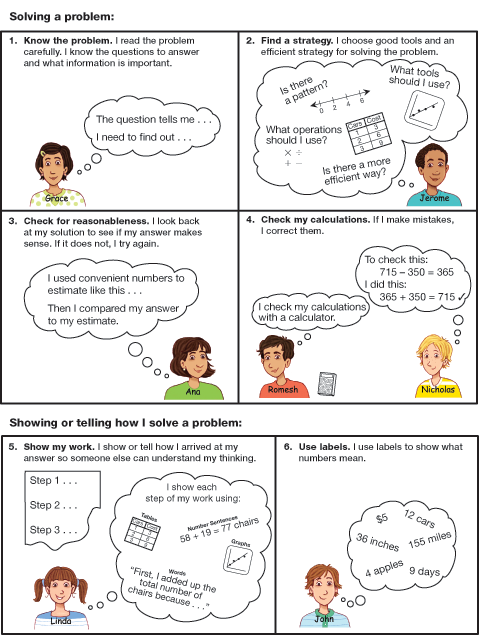| Key Ideas in Unit 1 |
L1 TG |
L2 SAB |
L3 SAB |
L3 SAB |
L3 SAB |
L3 DPP |
L4 DPP |
L4 TG |
L5 SAB |
L5 DPP |
L5 DPP |
||
| Unit 1 Expectations | |||||||||||||
Math Content |
|||||||||||||
|
Data 1 Data Collection: Select, collect, and organize data to answer questions, solve problems, and make predictions. |
|||||||||||||
E1 |
Represent the variables and procedures of an investigation in a drawing. (Algebra 1) [MP4, 6.SP.1] |  |
|||||||||||
|
Data 2 Data Representation: Select and create appropriate representations, including tables and graphs, for organizing, displaying, and analyzing data. |
|||||||||||||
E2 |
Draw scaled bar and picture graphs from a table. (Algebra 2) [3.MD.3, MP4] |  |
 |
 |
 |
||||||||
|
Data 3 Data Description: Describe a data set by interpreting graphs, identifying patterns, and using statistical measures, e.g., average and range. |
|||||||||||||
E3 |
Read a table or scaled graph to find information about a data set. (Algebra 4) [3.MD.3, MP1, 2, 4] |  |
 |
 |
 |
||||||||
|
Data 4 Using Data: Apply relationships and patterns in data to solve problems, develop generalizations, and make predictions. |
|||||||||||||
E4 |
Make predictions and generalizations about a population from a sample using data tables and graphs. (Algebra 4) [MP2, 4, 5] |  |
 |
 |
|||||||||
E5 |
Solve one- and two-step problems using data in scaled bar and picture graphs. [3.MD.3, MP2] |  |
 |
||||||||||
|
Number 1 Number Sense: Understand the base-ten number system, recognize relationships among quantities and numbers, and represent numbers in multiple ways. |
|||||||||||||
E6 |
Represent whole number sums on number lines. [3.MD.6, 3.NBT.2] |  |
 |
||||||||||
Math Facts |
|||||||||||||
|
Number 3 Computation and Estimation: Use efficient and flexible procedures to compute accurately and make reasonable estimates. |
|||||||||||||
E7 |
Demonstrate fluency with the addition facts. [2.0A.2] |  |
 |
||||||||||
Math Practices |
|||||||||||||
| MPE1 | Know the problem. I read the problem carefully. I know the questions to answer and what information is important. | ||||||||||||
| MPE2 | Find a strategy. I choose good tools and an efficient strategy for solving the problem. | ||||||||||||
| MPE3 | Check for reasonableness. I look back at my solution to see if my answer makes sense. If it does not, I try again. | ||||||||||||
| MPE4 | Check my calculations. If I make mistakes, I correct them. | ||||||||||||
| MPE5 | Show my work. I show or tell how I arrived at my answer so that someone else can understand my thinking. [MP3] |  |
 |
||||||||||
| MPE6 | Use labels. I use labels to show what numbers mean. | ||||||||||||

Yellow
Green
Blue
Red
Magenta
Remove













